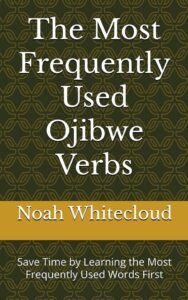Fraudulent Anishinaabemowin resources a serious concern
 By Marci Becking
By Marci Becking
NIPISSING FIRST NATION— Artificial Intelligence (A.I.) has been rapidly evolving and becoming more ingrained within society – at school and work, social media – its use and misuse has had an impact on us all and its use has even crept into the Anishinaabemowin world.
Last month, Anishinabek Nation’s Anishinaabemowin Coordinator Laurie McLeod-Shabogesic ordered a book off Amazon and was shocked to find that it had been created by A.I.
“I’m an avid collector of Anishinaabemowin resources and am always on the lookout for new releases. I saw one on Amazon and ordered it. The setup is nice and at first glance, it probably looks like a great resource, but it is riddled with inaccurate translations. I was quite taken aback and started to ask my language friends if they had seen it yet. My son, who is an Anishinaabemowin teacher, and his friend did. Apparently, this is happening with a number of Indigenous languages,” says McLeod-Shabogesic. “‘Someone’ creates a fake author profile claiming to be a lifelong teacher and language advocate. The ‘author’s’ name and community changes depending on the Indigenous language. They use ‘lazy’ A.I. to generate the information, slap it into a book, and start selling. My heart goes out to new learners who may think it’s a great resource and then later become hurt and discouraged as they try to use what they have ‘learned’. Do not buy this book.”
The book is called, The Most Frequently Used Ojibwe Verbs: Save Time by Learning the Most Frequently Used Words First by Noah Whitecloud. With the ease of creating publications through services like Instant ChatGBT Ebooks or the A.I. Publishing Academy, it’s concerning at how just anyone can create anything and claim that it is a learning resource. Several other languages are being exploited, including Plains Cree, Inuktitut, and Yurok.
“Language is an extremely sensitive issue for many Indigenous nations. Because of Indian Residential and Day Schools, our people have experienced a lot of trauma for speaking and sharing our language. As a result, many of our languages are on the verge of extinction. As our people strive to save our languages, inaccurate resources such as these ones not only hurt learners who later have to unlearn this misinformation, but the resources also compromise the long-term integrity of our languages,” says McLeod-Shabogesic. “Our languages are a sacred gift from Creator. To try to steal and exploit our words for monetary gain is cruel and unconscionable. A.I. may someday become a valuable resource for language at this point in time though, it really isn’t. Technology cannot perceive wisdom and can so easily be manipulated. If anything, this truly emphasizes that even technology needs a spirit to carry it.”
What can learners do to identify A.I.-generated learning resources? Look for inconsistencies like abrupt shifts in tone or style, excessive use of buzzwords or jargon could be an indication of A.I. trying to fill in gaps in its knowledge or even use placeholders (i.e., [Insert information here]) when it cannot fill in the gaps, lack of citations or unfounded citations, and incoherent sentences or missing words and sentences. It can be difficult to identify A.I. as it is ever-changing and we also have to account for human error as mistakes can happen in writing; however, being mindful that this is a possibility and doing a little more research before buying (such as reading reviews) can be helpful.
In the meantime, McLeod-Shabogesic is using her experience as a cautionary tale and has reported the resource to Amazon as she believes they should take some responsibility for selling fake learning resources and hopefully monitor this as A.I. .


